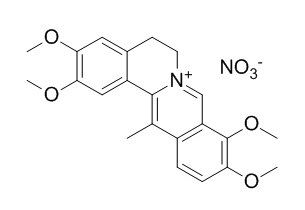Dehydrocorydaline nitrate
Dehydrocorydaline has anti-inflammatory activity, it has antinociceptive effects in mouse models of inflammatory pain, the effects involve the opioid receptor and inflammatory cytokines. Dehydrocorydaline can inhibit elevated mitochondrial membrane potential in lipopolysaccharide-stimulated macrophages.Dehydrocorydaline not only inhibits antibody-mediated allergic reactions but also influences cell-mediated allergic reactions, and the inhibitory effect of Corydalis Tuber on allergic reactions may be partially attributed to dehydrocorydaline.
Inquire / Order:
manager@chemfaces.com
Technical Inquiries:
service@chemfaces.com
Tel:
+86-27-84237783
Fax:
+86-27-84254680
Address:
1 Building, No. 83, CheCheng Rd., Wuhan Economic and Technological Development Zone, Wuhan, Hubei 430056, PRC
Providing storage is as stated on the product vial and the vial is kept tightly sealed, the product can be stored for up to
24 months(2-8C).
Wherever possible, you should prepare and use solutions on the same day. However, if you need to make up stock solutions in advance, we recommend that you store the solution as aliquots in tightly sealed vials at -20C. Generally, these will be useable for up to two weeks. Before use, and prior to opening the vial we recommend that you allow your product to equilibrate to room temperature for at least 1 hour.
Need more advice on solubility, usage and handling? Please email to: service@chemfaces.com
The packaging of the product may have turned upside down during transportation, resulting in the natural compounds adhering to the neck or cap of the vial. take the vial out of its packaging and gently shake to let the compounds fall to the bottom of the vial. for liquid products, centrifuge at 200-500 RPM to gather the liquid at the bottom of the vial. try to avoid loss or contamination during handling.
J Ethnopharmacol.2024, 333:118415.
Agronomy2023, 13(9), 2410.
Antioxidants (Basel).2022, 11(10):1929.
J of Food Quality2020, 8851285.
Drug Des Devel Ther.2020, 14:61-71
J Food Sci.2022, 87(11):4905-4916.
Korea Food Research Institute2024, 4798082
Molecules.2022, 27(21):7643.
Molecules.2023, 28(3):958.
Acta Chromatographica2016, 29(3)
Related and Featured Products
Int. Immunopharmacol., 2011, 11(9):1362-7.
Dehydrocorydaline inhibits elevated mitochondrial membrane potential in lipopolysaccharide-stimulated macrophages.[Pubmed:
21575743 ]
Activated macrophages play a critical role in the pathogenesis of numerous diseases by producing pro-inflammatory cytokines such as interleukin (IL)-1β and IL-6. While the mechanisms of bacterial component recognition and signal transduction have been well investigated, viability regulation in activated macrophages remains unclear.
METHODS AND RESULTS:
We screened herbal ingredients to find an agent that reduces the viability of lipopolysaccharide (LPS)-stimulated macrophages and observed that dehydrocorydaline, a component of Corydalis yanhusuo, reduced the viability of macrophage-derived RAW264.7 cells and primary macrophages in the presence of LPS. Dehydrocorydaline inhibited the elevation of mitochondrial membrane potential and induced ATP depletion in LPS-stimulated macrophages but neither affected basal mitochondrial membrane potential nor ATP content in non-stimulated macrophages. Dehydrocorydaline also prevented increased concentrations of IL-1β and IL-6 in culture media of LPS-stimulated macrophages.
CONCLUSIONS:
Mode of dehydrocorydaline action indicates that elevated mitochondrial membrane potential may be a novel target to specifically reduce viability and suppress cytokine production in LPS-stimulated macrophages.



